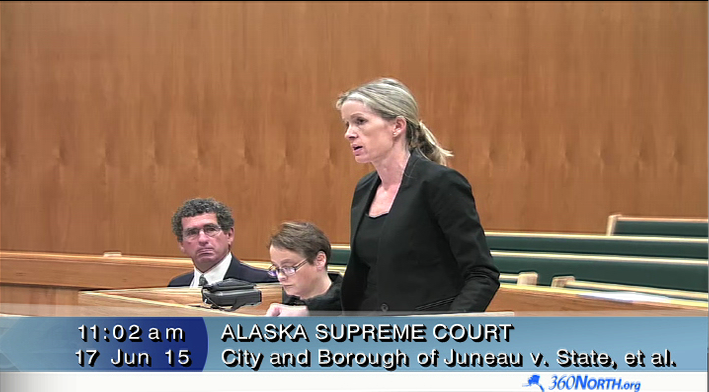
The state Supreme Court heard arguments in a local boundary case Wednesday that could redraw lines around a Delaware-sized chunk of Southeast Alaska.
The contested land is almost completely uninhabited national forest – Juneau “estimated” the population at one – but with the land goes potential federal receipts, some property and sales tax revenue, and local authority.
The Local Boundary Commission case pits Juneau against Petersburg.
Within 5 minutes of Juneau’s attorney beginning her arguments in the Alaska Supreme Court, Chief Justice Dana Fabe interrupted with this question:
“Given that the LBC has the discretion not to consolidate, and has even the discretion whether to consider relevant information from concurring or conflicting petitions, and given you haven’t challenged the constitutionality of that regulation or even challenged the LBC’s exercise of its discretion in how it proceeded, why doesn’t that end the case?”
There’s a lot of technical legal stuff that could be unpacked in that question, but the takeaway is that Fabe was wondering out loud if Juneau had a case at all.
The boundary beef stems from Petersburg’s dissolution as a city and reincorporation as a geographically much bigger borough in 2013. Its northern border now comes to Holkham Bay, where Tracy and Endicott arms empty into Stephens Passage.
The usual authority on these matters, the state’s Local Boundary Commission, cut about 500 square miles of land around Tracy Arm from Petersburg’s original annexation request. It was a concession to Juneau, where tourism connections made it a better fit, commissioners said.
But Juneau wants an additional 1,500 square miles excluded from the Petersburg Borough and argues it has better claims to those lands and waterways that weren’t properly considered by the commission.
Mead noted the commission itself supported Juneau in the contested area in a boundary study last revised in 1997. The justices asked several questions trying to parse out exactly what Juneau alleges the Local Boundary Commission did wrong. Eventually, Juneau attorney Amy Mead summed it up like this:
“What we’re saying is that the analysis that they engaged in, which is apparent from a reading of that decisional document, is constitutionally infirm. That is our argument.”
She argued the analysis was weak specifically with respect to Article X, Section 3 of the state constitution that says, “Each borough shall embrace an area and population with common interests to the maximum degree possible.”
“Article X is properly understood as a rough guideline,” said state attorney Janell Hafner, representing the Local Boundary Commission. “It is not a rigid blueprint. It is not a standalone, fixed mandate that directs what a borough boundary must look like at any one point. Nor does it direct the manner in which the commission evaluates the decision among competing boundaries is the best fit.”
She and Jim Brennan, the attorney for Petersburg, both argued that the commission properly weighed the competing claims and acted within its authority.
Brennan took particular offense to Juneau’s assertion that the commission limited its participation in the annexation proceedings. He noted a 58-page report by the Juneau Economic Development Council.
“That was considered. Petersburg rebutted it. Petersburg went through a point by point rebuttal of that study,” Brennan said. “And also showed that Petersburg’s commercial fisheries connections with the area were substantially greater.”
Petersburg fisherman are responsible for more than 90 percent of commercial haul from the contested area; Juneau businesses and residents own most of the private land.
The commission also held a 3-day hearing in Petersburg on the competing annexations in 2012 that Brennan attended.
“I must have been at a different proceeding than was discussed by Juneau,” Brennan said. “The main question was, ‘Who’s got the greater connections, Juneau or Petersburg?’ That’s what the hearing was all about. Juneau brought down 10 witnesses. They were not precluded from presenting anything.”
Justice Craig Stowers asked, if Juneau prevails, what can the court do to satisfy Juneau?
Mead said Juneau doesn’t want to force Petersburg to revert to city status, but the court could order the commission to revisit the competing annexation claim with more evidence and more hearings.
The court usually publishes its decisions within 9 months of hearing arguments.
